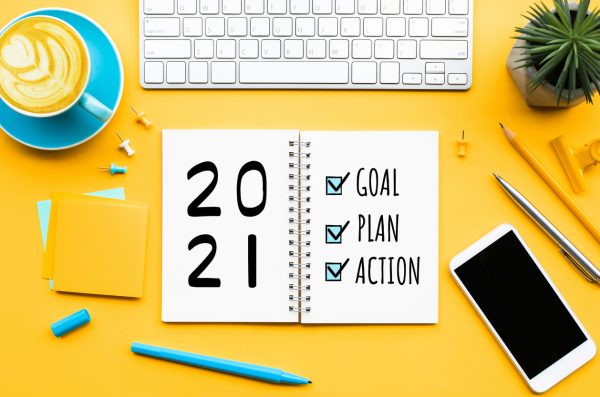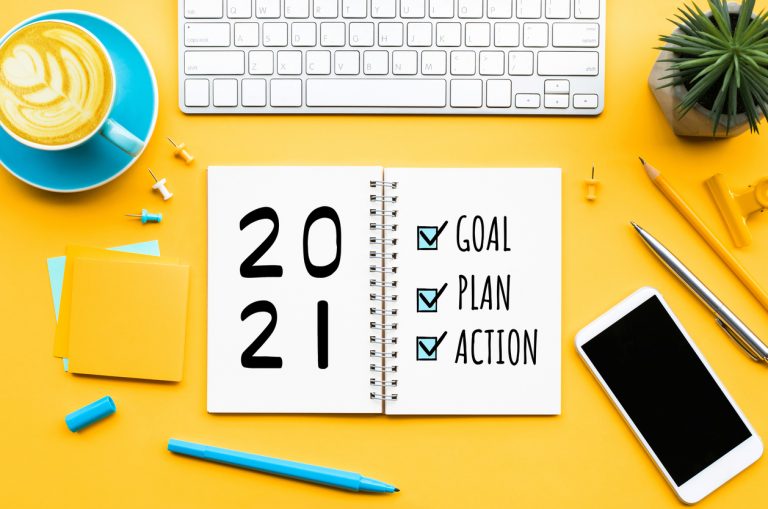As we say goodbye to 2020, there’s no better time to reflect on the challenges and successes of the past year and start planning for the twelve months ahead. The start of a new calendar marks a fresh slate ready to be met with enthusiasm and renewed inspiration. Yet, many artists find it difficult to settle back into their usual routine after an extended break. If you’re struggling to get out of the post-holiday slump, our guide to 2021 New Year’s resolutions for artists will help rekindle your creative spark in no time.
1. Reflect.
In order to get the most out of New Year’s resolutions, it’s important to review where you’re currently at. Take a couple of hours to reflect on what you achieved over the past year. Did you accomplish the goals you set? If so, what helped you? Carry your successful strategies into next year by incorporating them into a new plan.
If not, what prevented you from meeting them? Identifying obstacles to your progress is imperative to move beyond them. What specific challenges did you face and what did you learn from them? If you struggled finding time for your artwork, for example, you may consider a change of schedule, or simply committing to a ten-minute sketch each day to keep inspiration flowing. Your first resolution should be addressing those areas you fell short of your goals in 2020, and making suitable adjustments for 2021.
2. Set long-term and short-term goals.

Ideally, your short-term goals should correspond to your long-term goals. Where would you like to be in the next 3–5 years? Maybe you’d like to have your own exhibition, website, or to meet a specific sales target. When planning your monthly and yearly goals, it helps to bear the ‘bigger picture’ in mind to help you keep on track. Once you’ve set yourself three long term goals, break down each one into 8–10 smaller, more manageable steps.
For example, if you’d like to increase your sales, your short-term goals may focus on creating an effective marketing strategy. This could include photographing your work, researching web designers and hosting sites, creating an Instagram account and applying to sell at artisan markets. Breaking big ambitions into achievable micro-steps prevents feeling overwhelmed and allows you to keep up that January momentum all year round.
3. Master deadlines and accountability.
Finding inspiration is crucial for artists, but pales in comparison to good old-fashioned hard work. As an artist, it can be challenging to self-motivate and keep to deadlines which are often self-imposed, so seeking support in your endeavours can make all the difference. One major reason New Year’s resolutions often fail is lack of clarity and accountability. By creating a clear calendar and asking a friend or colleague to help you stick to it, you are much more likely to meet your deadlines and achieve your goals.
Try the Google Calendar tool, which allows you to share your schedule with another person or group and reciprocate by checking in with your accountability partner on their progress with their own goals.
4. Learn something new!

The New Year is a great time to expand your skill set and try new things. If there’s a particular medium or technique you’ve been keen to try out, take the opportunity to sign up to a local or online class. Have you always loved pottery but never strayed from paint? Now is the time to shake things up! Sometimes breaking out of our comfort zone can lead to huge creative breakthroughs, helping you learn about and adapt your established creative processes. Lean into experimentation and have fun with it.
Check out our Media in focus series for some inspiration:
- Media in focus: vellum
- Media in focus: painting on copper
- Media in focus: Chinese traditional painting
- Media in focus: egg tempera
- Media in focus: portrait miniatures
- Media in focus: tapestry
5. Make your practice sustainable.

Environmental issues can often feel beyond our individual control, but there are many small adjustments we can make to our daily lives that contribute toward a greener planet and inspire others to do the same. Consider the ways in which you could adapt your materials and processes to be more eco-conscious. This could be as simple as buying products that are animal-friendly and biodegradable, or as intricate as Faith Bebbington’s sculptures made from recycled materials.
Practical issues of sustainability have never been more important, so what changes could you make to help make a difference?
6. Do a little, often.
Confronting a large project can feel insurmountable and intimidating at first, but it’s important to keep chipping away in order to preserve enthusiasm and drive it forward. For those juggling many different commitments, dedicating full days to work on an art project is not always realistic, but that needn’t be a deal-breaker. Spending just one hour a night working towards your goal is all you need. Be consistent and you’ll soon see that those hour-long sessions quickly add up!
7. Grow your audience and artist network.
Put that fresh New Year energy to good use by making meaningful connections with fans of your work, clients, and fellow artists. Joining an artist network, creating a weekly newsletter, or consolidating your social media game are great ways to forge new relationships and get your artwork noticed by the right people. In our increasingly digital world, maintaining an online presence is an important part of any marketing strategy, but it’s no substitute for face-to-face communication. Check out our article on making connections in the art world for tips on how to grow your network. Making art can be a uniquely solitary pursuit, so make it a priority this year to surround yourself with a creative, encouraging community.
8. Keep an artist’s journal.

Keeping a journal is an excellent way to document your growth, not only as an artist, but as an individual. A journal offers a space to reflect on the world around you, your progress and thoughts. I like to take my journal to exhibitions, documenting any quotes that stand out, making quick sketches, or jotting down ideas that come up whilst looking at a piece. Afterward, I note my thoughts on the exhibition as a whole: what I liked, what I learnt, what I would have done differently. This method can be applied to almost anything, such as the books you read, the films you watch, even your dreams. Looking back on old journals can also be a great source of inspiration when the well runs dry — a catalogue of ideas for a rainy day!
We hope these tips have helped you think about what you might want to improve on in 2021, and how to go about sticking to your goals. Wishing you a happy new year from ArtWeb!







